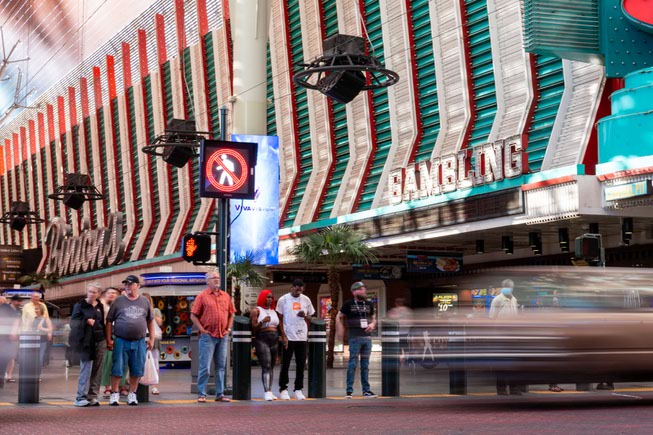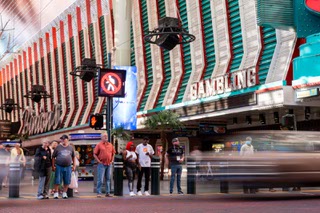
The city of Las Vegas is taking a new approach towards crosswalk signs and is testing an artificial intelligence system that could train crosswalks signs to time themselves. The crosswalk located at Casino Center Blvd and Fremont Street Experience is part of this crosswalk testing in Las Vegas, Nevada, Tuesday, March 19, 2024.
Sunday, March 24, 2024 | 2 a.m.
The pedestrian crossing light flashes white at an intersection in downtown Las Vegas and a gaggle of people begin to make their trek across the road.
One person isn’t keeping up with the crowd and barely makes it to the middle of the crosswalk as the digital sign counts down. Even as the traffic light turns green, the pedestrian may not have made it to the other side, increasing their chances of getting struck by a car.
This scene plays out daily in many crosswalks across the city (and nationally) as senior adults, those with mobility issues and others are put in harm’s way.
The City of Las Vegas is taking a new approach to address the problem.
It is testing an artificial intelligence system that could train crosswalk signs to time themselves based on the person crossing the road.
Using data on pedestrian volumes and speed, the projects will be tailored to detect pedestrians waiting to cross roads and adjust traffic signal timing and unprotected crossing flasher durations in real time. Traffic signals with crosswalks time the duration for pedestrians according to a 3 1/2-feet-per-second formula, said Erin Breen, director of the Road Equity Alliance Project.
“The city has cool technology, and when they don’t have cool technology, they have developed their own cool things to help pedestrians,” Breen said. “It’s interesting to see that they can roll out technology that you know is going to make a difference.”
Las Vegas is receiving $1.4 million from the Bipartisan Infrastructure Law to improve pedestrian safety on Fremont Street. The monies were secured by Rep. Dina Titus, D-Nev., whose congressional district includes downtown.
The project is part of the law’s Strengthening Mobility and Revolutionizing Transportation (SMART) grant program for the SMARTer and Safer Way to Cross project by the Department of Transportation. The initiative invests funds in AI-powered pedestrian detection systems that are said to allow “the appropriate amount of time for street crossings,” Titus’ office said in a statement.
It’s technology Breen said many “people have been chasing for a long time.”
Las Vegas will pilot the project around the Fremont Street corridor, which attracts more than 26 million visitors per year and includes the Fremont Street Experience — an area where “large numbers of pedestrians walk across the intersecting streets and to nearby hotels, casinos and restaurants,” the city said.
The project will span from Carson Avenue to the south, Main Street to the west, Ogden Avenue to the north and Las Vegas Boulevard to the east. At least a dozen intersections will be outfitted with cameras that “talk” to nearby traffic signals to “create safer outcomes when pedestrians are crossing the street,” city officials said.
It’s expected to be installed and operational in early 2025, the city said. Fremont Street was chosen as the test location for its “high numbers of pedestrians in that area that cross busy streets.”
“The city of Las Vegas is thankful for these federal grant funds so that this new technology can be tested and potentially lead to our roadways being safer for everyone,” said Joey Paskey, the city’s director of Public Works, in a statement to the Sun. “The city is committed to safety through our Vision Zero program.”
Titus in October sent a letter to U.S. Department of Transportation Secretary Pete Buttigieg supporting the project.
Titus noted how Las Vegas is one of two entities in Nevada with approved Vision Zero Safety Action Plans — a strategy “to eliminate all traffic fatalities and severe injuries” as well as create safer ways to travel, according to the city. The other entity is Washoe County.
“We are excited to support both agencies as they test new safety technologies in different environments and situations, including prioritizing pedestrian movement in tourist locations, school zones, high-speed arterials, Justice40 communities, and the urban downtown core,” Titus said in the letter that was also signed by all of Nevada’s federal delegation.
Las Vegas this year has already recorded 26 pedestrian fatalities, with 18 in January alone, Breen said.
Nevada has seen 58 pedestrian deaths as of last week, an almost 32% jump in fatalities from the same time last year, according to Zero Fatalities Nevada, an organization sponsored by the Nevada Department of Public Safety.
By comparison, there were 385 total traffic-related deaths across the state in 2023, 416 in 2022 and 349 in 2021.
One could point the finger at several bad behaviors that lead to traffic fatalities, such as impaired or distracted driving, speeding and running red lights, Breen said. She also acknowledged that pedestrians rushing to cross the street, many times outside of a crosswalk, and the lack of consequences for jaywalking can also be a problem.
Breen said she’s excited for this new project to be piloted in Las Vegas and lauded the city’s efforts to increase pedestrian safety in the region.
She hopes the data collected will show how effective these technologies can be in creating safer crosswalks and wants to expand it into neighborhoods where she says it may be even more beneficial — especially in areas with senior housing.
In addition to the AI-powered traffic signals, Breen also wants to see brighter street lighting, more access to safe street crossings and lower speed limits on streets like Flamingo Road or Charleston Boulevard.
“There’s no reason to believe (this project) is not going to work,” Breen said. “(But) you can’t assume that technology alone is enough because it’s not, ever. It’s everybody’s job to make sure that everybody on the road gets home safely, and that’s the community.”
[email protected] / 702-948-7854 / @gracedarocha

